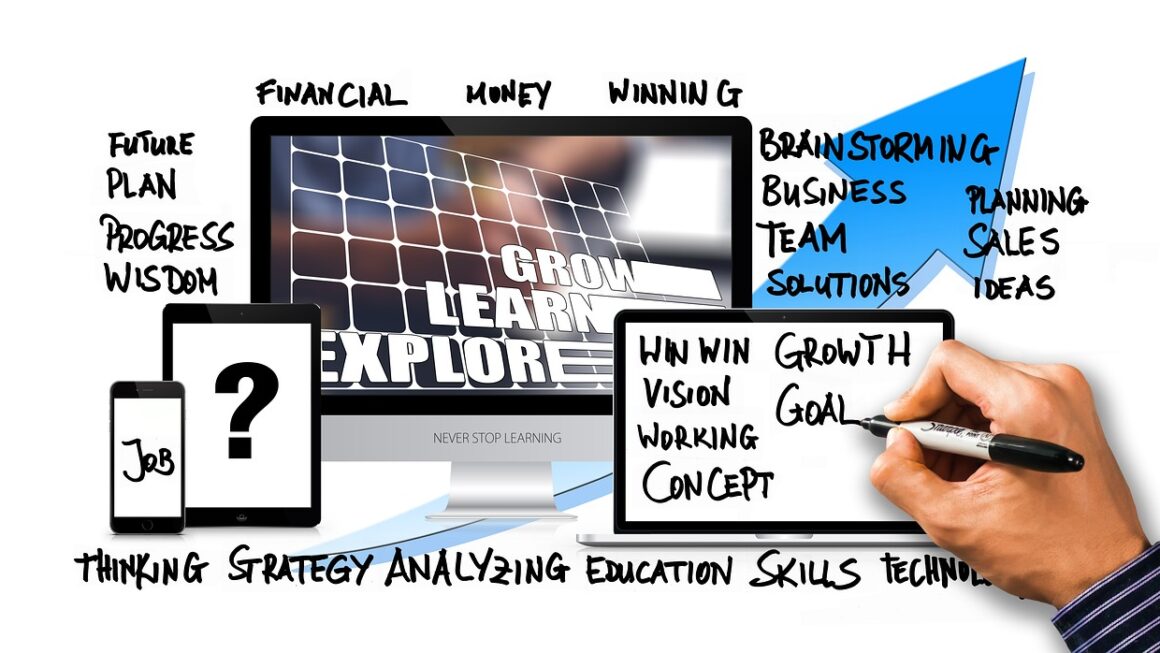Living in the digital age means more than just owning a smartphone or knowing how to use social media. It’s about integrating digital technology into every facet of your life, from how you work and communicate to how you learn and relax. This shift, often referred to as the “digital lifestyle,” offers unprecedented opportunities for flexibility, connection, and personal growth. But it also comes with its own set of challenges that require thoughtful navigation. Let’s delve into the various aspects of embracing a digital lifestyle.
Understanding the Digital Lifestyle
Defining the Digital Lifestyle
The digital lifestyle is characterized by the pervasive use of technology and digital tools to manage and enhance various aspects of daily life. It involves leveraging technology for communication, productivity, entertainment, education, and even personal well-being. This lifestyle is not just about being online; it’s about intentionally using digital resources to create a more efficient, connected, and fulfilling existence.
- Key components of a digital lifestyle:
Remote work/Location independence: The ability to work from anywhere with an internet connection.
Online learning: Accessing educational resources and courses online.
Digital communication: Using tools like email, social media, and messaging apps to stay connected.
E-commerce and online services: Utilizing online platforms for shopping, banking, and other services.
Digital entertainment: Consuming content through streaming services, podcasts, and online gaming.
The Rise of Digital Nomadism
Digital nomadism is a specific type of digital lifestyle where individuals embrace location independence and travel the world while working remotely. This trend has gained significant popularity in recent years, fueled by advancements in technology and a desire for greater freedom and flexibility.
- Factors contributing to the rise of digital nomadism:
Increased availability of remote work opportunities: Many companies now offer remote work options.
Affordable travel options: Budget airlines and accommodation platforms have made travel more accessible.
Stronger internet infrastructure globally: Reliable internet connectivity is crucial for digital nomads.
Growing community of digital nomads: Online communities provide support, resources, and networking opportunities.
Benefits of Embracing a Digital Lifestyle
Increased Flexibility and Freedom
One of the most significant advantages of a digital lifestyle is the flexibility and freedom it offers. You’re no longer tied to a specific location or rigid work schedule.
- Examples of increased flexibility:
Setting your own hours and working when you’re most productive.
Choosing where to live and work, allowing for travel and exploration.
Balancing work and personal life more effectively.
Enhanced Productivity and Efficiency
Digital tools and technologies can significantly enhance your productivity and efficiency. Automation, collaboration platforms, and project management tools streamline tasks and improve workflows.
- Examples of productivity-enhancing tools:
Project management software: Asana, Trello, Monday.com
Communication platforms: Slack, Microsoft Teams
Automation tools: Zapier, IFTTT
Note-taking apps: Evernote, Notion
Expanded Learning and Growth Opportunities
The digital world offers endless opportunities for learning and personal growth. Online courses, webinars, and educational resources are readily available, allowing you to acquire new skills and knowledge at your own pace.
- Platforms for online learning:
Coursera
Udemy
edX
Skillshare
Improved Communication and Connectivity
Digital tools facilitate seamless communication and connectivity with friends, family, and colleagues. Social media, messaging apps, and video conferencing platforms allow you to stay in touch regardless of location.
- Tools for improved communication:
Zoom
Google Meet
Slack
Challenges of the Digital Lifestyle
Digital Overload and Burnout
One of the biggest challenges of the digital lifestyle is the risk of digital overload and burnout. Constant connectivity and exposure to information can lead to stress, anxiety, and exhaustion.
- Strategies for managing digital overload:
Set boundaries: Establish specific times for work and personal activities.
Take regular breaks: Disconnect from technology and engage in offline activities.
Practice mindfulness: Focus on the present moment and reduce stress.
Prioritize sleep: Ensure you get enough rest to recharge.
Privacy and Security Concerns
The digital lifestyle also raises concerns about privacy and security. Online activities can expose you to cyber threats, data breaches, and privacy violations.
- Tips for protecting your privacy and security:
Use strong passwords: Create unique and complex passwords for all your accounts.
Enable two-factor authentication: Add an extra layer of security to your accounts.
Be cautious of phishing scams: Avoid clicking on suspicious links or providing personal information.
Use a VPN: Encrypt your internet traffic and protect your online activity.
Keep software updated: Regularly update your software to patch security vulnerabilities.
Maintaining a Healthy Work-Life Balance
Balancing work and personal life can be challenging when your work is integrated into your digital environment. It’s crucial to establish clear boundaries and prioritize your well-being.
- Strategies for maintaining a healthy work-life balance:
Set realistic goals: Avoid overcommitting and prioritize tasks.
Schedule downtime: Plan activities that you enjoy and help you relax.
Disconnect regularly: Turn off notifications and step away from your devices.
Seek support: Talk to friends, family, or a therapist about your challenges.
Tools and Technologies for a Digital Lifestyle
Essential Hardware and Software
A successful digital lifestyle relies on having the right tools and technologies. Investing in reliable hardware and software is crucial for productivity and efficiency.
- Essential hardware:
Laptop or desktop computer
Smartphone
Headphones or headset
External hard drive for backup
- Essential software:
Productivity suite (e.g., Microsoft Office, Google Workspace)
Communication platform (e.g., Slack, Microsoft Teams)
Cloud storage (e.g., Google Drive, Dropbox)
Password manager (e.g., LastPass, 1Password)
Cloud Computing and Storage
Cloud computing and storage are essential for accessing and sharing files and data from anywhere. Cloud services provide a secure and convenient way to store and manage your digital assets.
- Benefits of cloud computing and storage:
Accessibility: Access your files from any device with an internet connection.
Collaboration: Easily share files and collaborate with others in real-time.
Backup and recovery: Protect your data from loss or damage.
Scalability: Easily scale your storage capacity as needed.
Internet Connectivity and Infrastructure
Reliable internet connectivity is the foundation of a digital lifestyle. Investing in a high-speed internet connection and appropriate networking equipment is essential.
- Factors to consider when choosing internet connectivity:
Speed: Ensure you have sufficient bandwidth for your needs.
Reliability: Choose a provider with a stable network.
Security: Protect your network with a strong password and firewall.
Backup options: Consider having a backup internet connection in case of outages.
Building Your Own Digital Lifestyle
Identifying Your Goals and Priorities
The first step in building a digital lifestyle is to identify your goals and priorities. What do you want to achieve with this lifestyle? What are your values and interests?
- Questions to consider:
What are your career aspirations?
What are your personal goals?
What are your values and interests?
How do you want to spend your time?
What kind of lifestyle do you envision?
Creating a Digital Strategy
Once you have a clear understanding of your goals and priorities, you can create a digital strategy to help you achieve them. This strategy should outline the tools, technologies, and practices you will use to manage your digital life.
- Elements of a digital strategy:
Tools and technologies: Identify the hardware and software you will need.
Communication plan: Determine how you will stay connected with others.
Productivity system: Develop a system for managing your time and tasks.
Learning plan: Outline how you will acquire new skills and knowledge.
Financial plan: Manage your finances and budget effectively.
Adapting and Evolving
The digital world is constantly evolving, so it’s essential to be adaptable and open to change. Regularly evaluate your digital strategy and make adjustments as needed.
- Strategies for adapting and evolving:
Stay informed: Keep up-to-date with the latest technology trends.
Experiment: Try new tools and techniques to see what works best for you.
Seek feedback: Ask for input from others and be open to criticism.
Be flexible: Be willing to adjust your plans as needed.
Continuous learning: Never stop learning and growing.
Conclusion
Embracing a digital lifestyle offers incredible opportunities for freedom, flexibility, and personal growth. However, it also requires mindful management and a proactive approach to navigate the challenges. By understanding the key components, benefits, and potential pitfalls, you can intentionally design a digital lifestyle that aligns with your values and helps you achieve your goals. Remember to prioritize your well-being, protect your privacy, and continuously adapt to the ever-evolving digital landscape. With careful planning and execution, you can unlock the full potential of a truly fulfilling digital existence.




